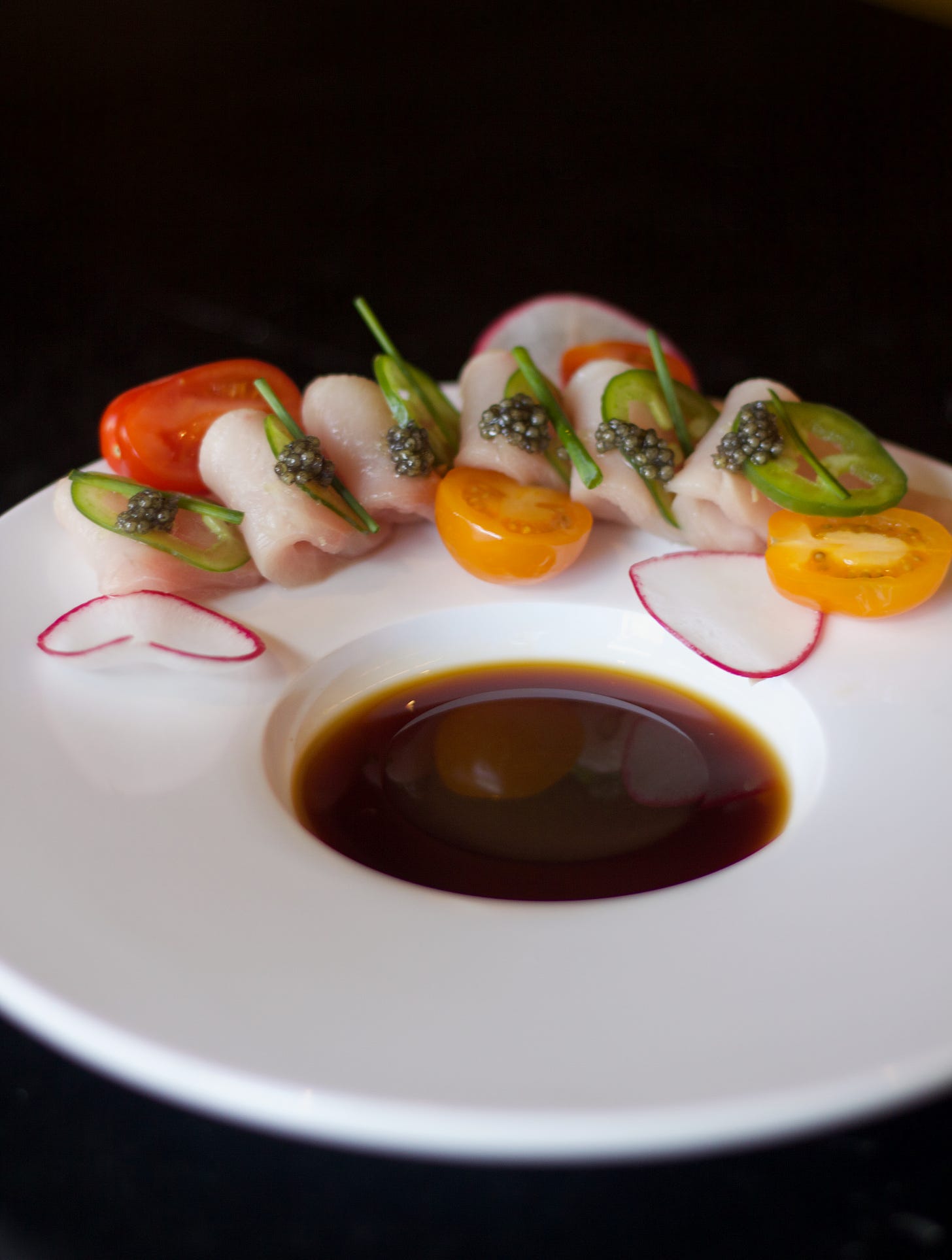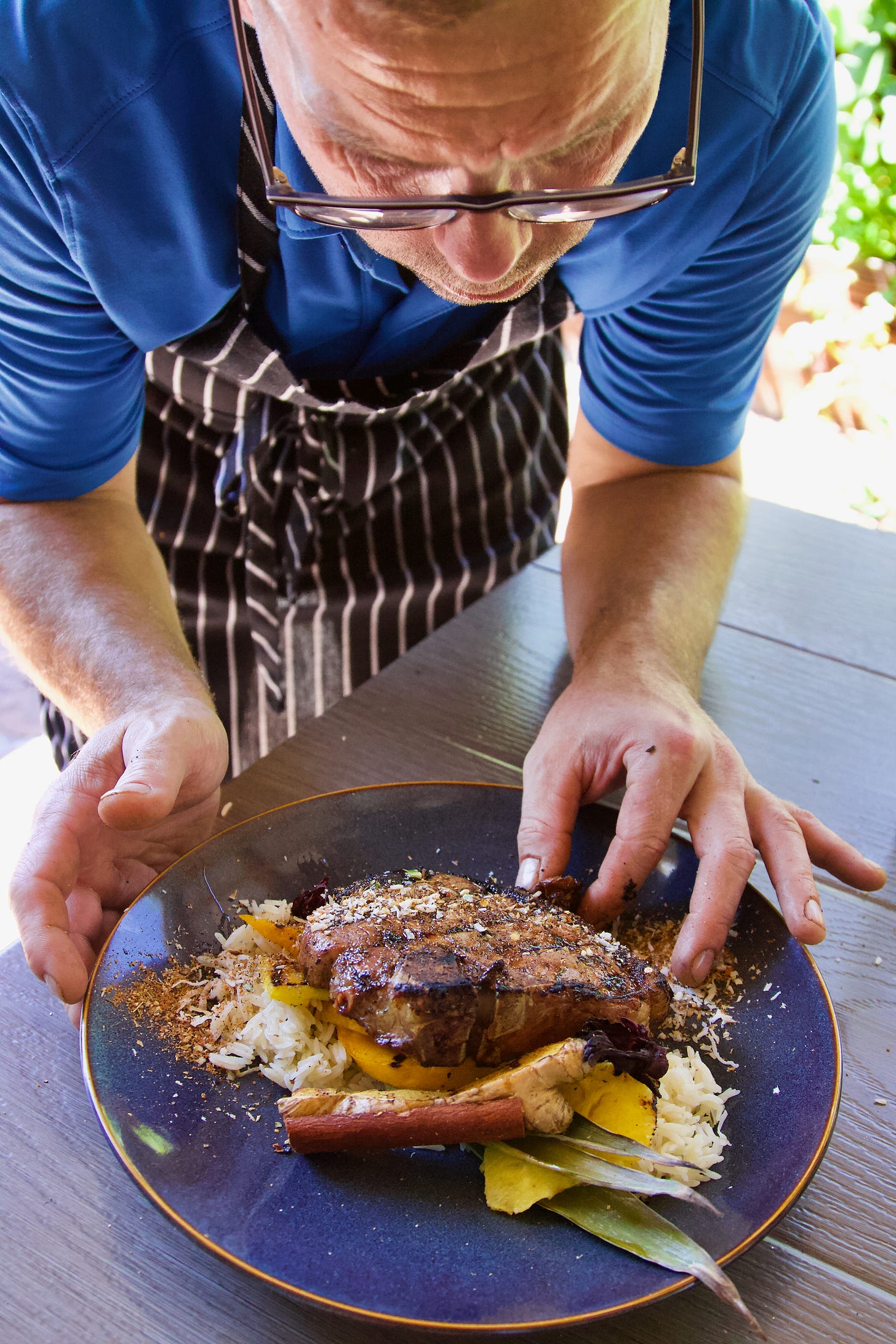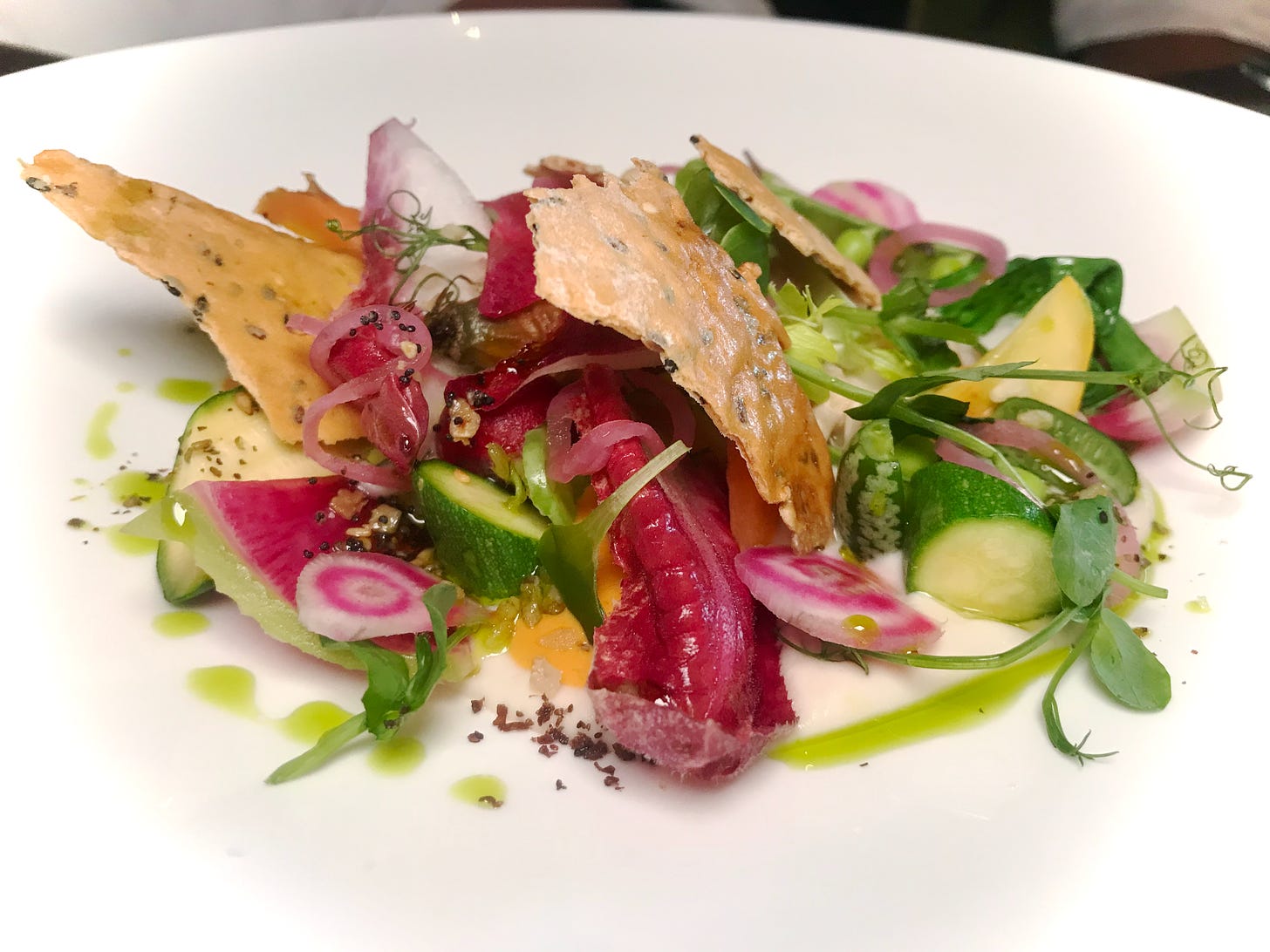
October is when we officially celebrate Arts Month locally, so consider this an amuse bouche, to whet the appetite for what approaches. But I hope you’re finding ways to incorporate art into your life regularly, be that through appreciation of the culinary arts (why you’re reading this newsletter), engagement with the visual and performing arts, or some other method of celebrating creative expression.
My setup is simple here: I asked nearly a dozen area chefs — with diversity of culture, cuisine and expertise in mind — “what considerations go into beautiful food presentation? How do you approach your plating?”
I requested roughly three to five sentences; some respondents were able to hit that while others took the liberty of longer answers. But their content’s good, so I’m running most of it long.
I then reviewed photos from my last six months of dining out to select some of my own favorite plate presentations I’ve seen (and you will have too if you’ve been with me from the beginning). And I gathered a couple other pics to round out a portfolio. Pay attention: Not all of the images correlate to quoted chefs. It’s all a hodgepodge here — my own artistic vision as the writer — and I didn’t want to box myself in to be restricted to coloring within the lines. So just go with it, and join me in a curated feast for the eyes. Here goes:
John Kuespert, Executive Chef at Cheyenne Mountain Zoo:
“When I approach the plating of a dish, many aspects of detail come to mind. Color palettes, textures, negative space, odd numbers, lighting, and guest perspective are all elements I take into consideration. Different ingredients interact with each other in different ways, being intentional with your actions and placements in plating help bring your blank canvas to life.”
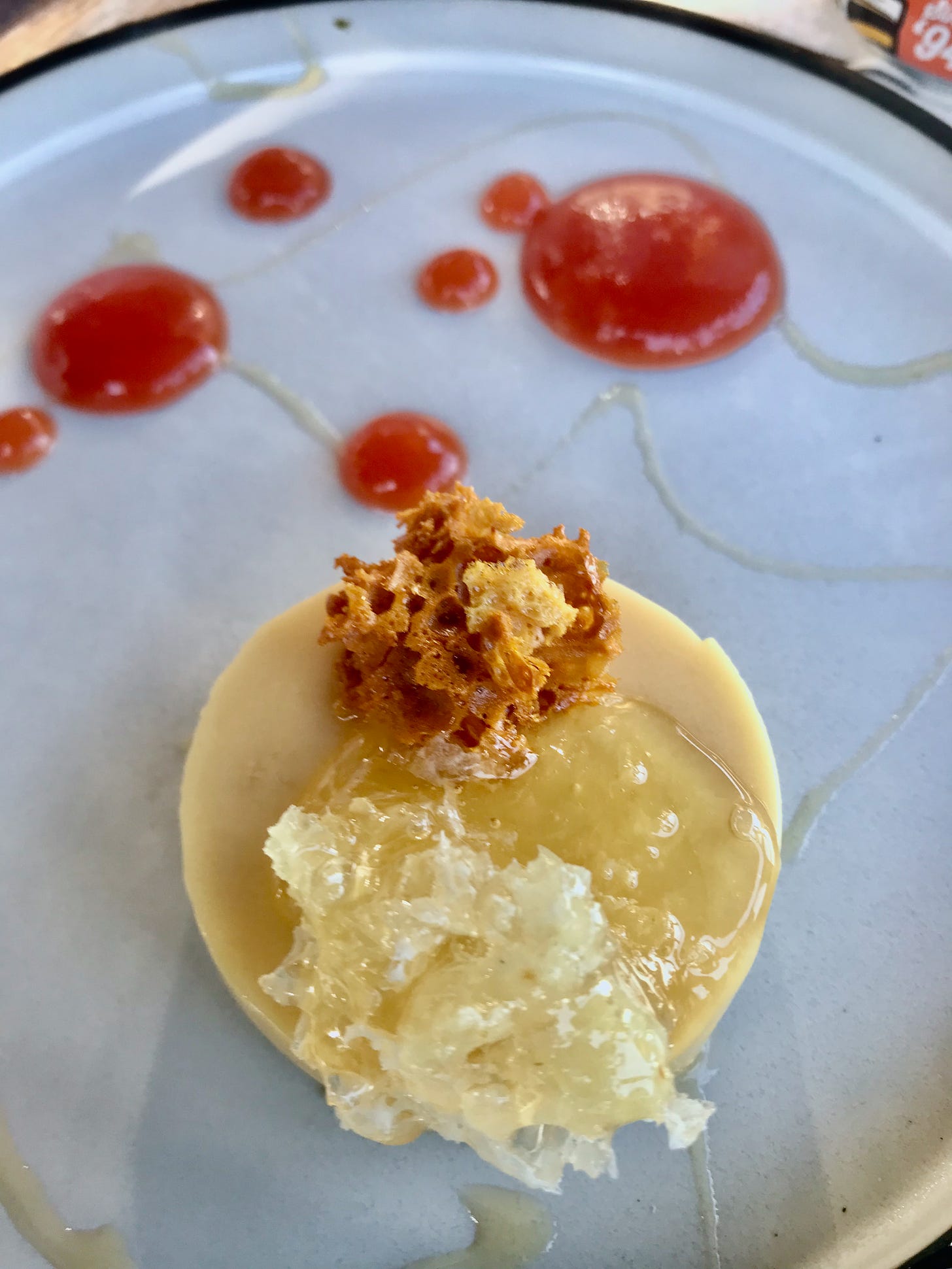
Monse Hines, Chef/Owner of Monse’s Taste of El Salvador and Sivar:
I like to approach food plating with three considerations in mind: culture, connection, and comfort. Firstly, food should tell a story; I like to think people are being introduced to me through my food and I enjoy sharing "who I am" with each dish. Secondly, I think plating reflects the amount of care invested in the preparation. Each plate connects you to people and they should "see" and "taste" the effort behind the food. Thirdly, I think plating should represent the devotion behind the dish. I try to approach each dish with the same comfort and care that I would serve to family and friends.
Brother Luck, Chef/Owner at Four by Brother Luck, The Studio, Folklore Irish Pub:
You eat with your eyes first and foremost. When I create a plate presentation, my mind wanders to what will the guest receive internally during their first glance. Is it height, negative space, colors, textures, or movement? Was I able to trigger a memory or some type of soulful connection to the sensory experience. My goal is to always stimulate the mind before I reach your taste buds……
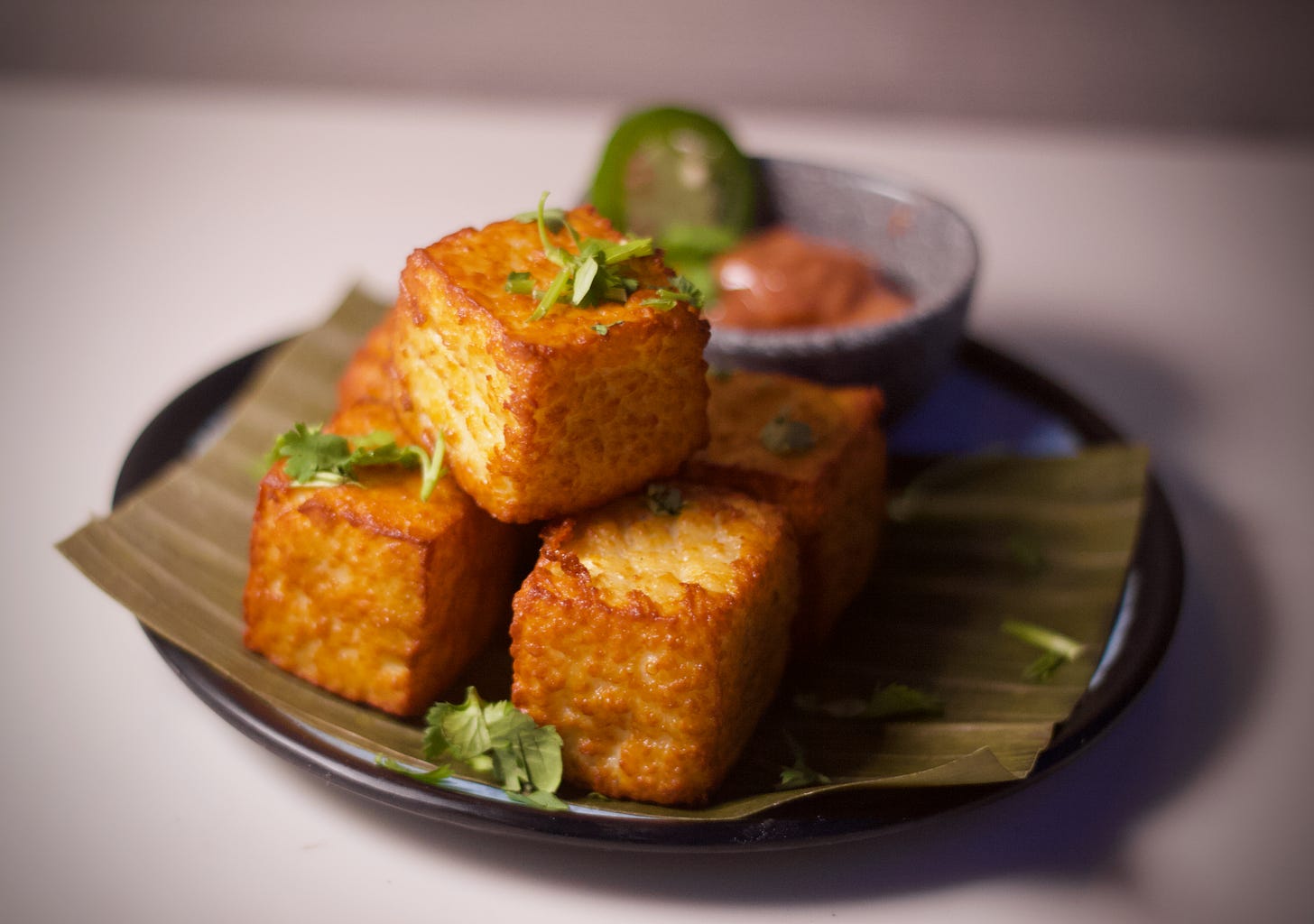
Beto Reyes, Chef at Milagros Cocina Mexicana:
“I never approach plating with the idea that I have to make it beautiful. I approach my plating with the idea that it’ll make my guest uncomfortable in the beginning. And as they dig in, my hopes are that they find comfort and beauty in the attempt of taking that risk. Approach it from an angle that no one else is willing to come from. And do it anyways.”
Chantal Lucas, Chef/Owner at Luchals:
Plating is truly in the eye of the beholder. A beautiful plate can change the perspective on how a guest sees your food. When you plate you are ultimately putting yourself on display. There is no one standard to plating. Speak to your guest on each plate with how you want to be heard.
Ian Dedrickson, Executive Chef/Owner at Ephemera:
Presentation of food in and of itself is multi-faceted. There are layers of elements to consider. Think about ease of consumption (grilled romaine is pretty, but undeniably annoying to deal with on the plate); then, your typical artistic composition standpoint (color theory, visual weight, blah blah pretentious blah blah blah); and, most importantly, does it matter or affect the guest's experience? A restaurant can put deeply creative thought into presentation that incorporates multiple senses. Artistically, I absolutely love all the "Chef's Table" restaurants that take that idea all the way, but I simply don't have the energy or resources or willingness to abuse my staff to accomplish it.
What's most important at an approachable and accessible level is whether the guest is going to care at all about how high you stacked some undressed bitter microgreens or not. Or, will they simply be annoyed by the inconveniently sculptural nonsense? Does all that work add to an experience or is it just egotistically in the way? It's crucial to remember not to take it too seriously in some artistic sense. It’s just food. Remember that what we do as chefs is a craft — a skilled trade — more so than an art.
At that, I love to encourage and be an active accomplice with my very talented team to create a "wow factor." Humbly starting at pushing how pretty a plate can evolvingly be. In fact, I outright demand that every plate be outstandingly pleasant at first sight. After all, we eat with our eyes first.
Noah Siebenaller, Executive Chef at Cheyenne Mountain Resort & Club:
Early on in Culinary School, one of my instructors taught us that a beautiful plate should never be symmetrical and not contain even numbers. This has stuck with me over the years and has become a part of every plate I create, whether it's a rustic presentation or an elevated presentation. We judge the taste of the dish based on the appearance of the plating. We assume it won't taste good if it doesn't look good.
Justin Miller, Executive Chef at The Broadmoor:
Our Chefs at The Broadmoor all have unique approaches on how they view their Culinary Artistry on the plate. First and foremost it starts with great ingredients and composition of flavor and seasonality. We look to incorporate variations of textures for highlighted ingredients to include cooked, raw and purees or sauces. We want to always consider that the guest first eats with their eyes. This is where our chefs get to enjoy the artistry of what we do for a living. Elevation and contrast of colors is important to consider when we create new content.
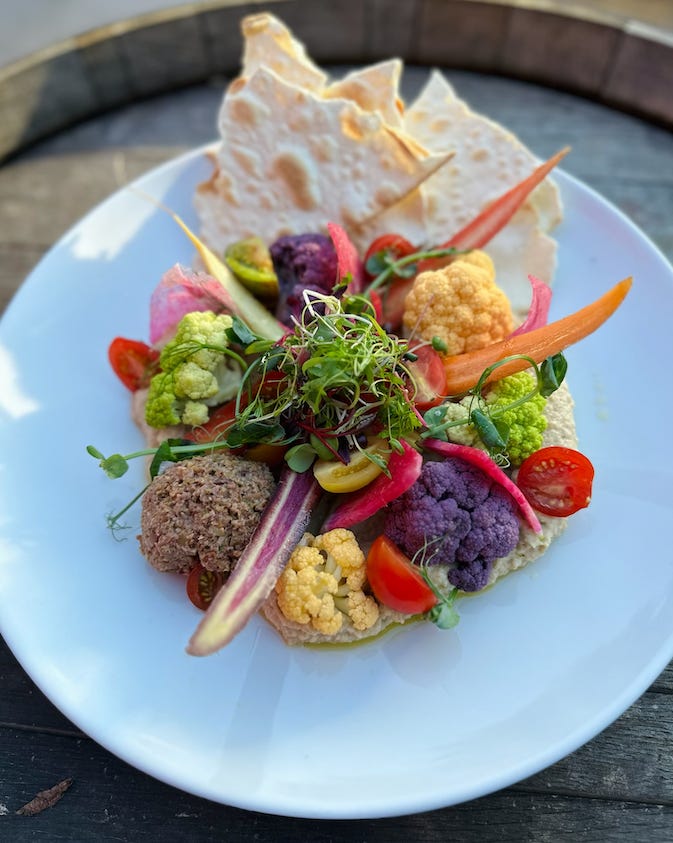
Nathan Potter, Teaching Kitchen Manager and Baking and Pastry Chef Instructor at The French Kitchen:
Whenever I'm plating savory dishes, I like to pick ingredients that not only taste good together but have different colors, shapes and textures. Also, I am old school in my approach insofar as taking quality ingredients and treating them simply, there are no gels, spheres, or foams. As for desserts, I love when I have multiple components with similar color profiles, sort of variations on a theme. It gets even better when the desserts use one ingredient multiple different ways within the dessert. There is something inherently beautiful in unity in theme and aesthetic.
Victor Matthews, Dean and Master Chef at Paragon Culinary School:
My approach is clean. I may be from the same town as Emeril, but I never garnish rims. I love negative space. My number one advice would be negative space to frame the food. Light and tight. Wide rims, large plates. Also be careful with color. People like dark plates but the food cannot also be dark. I am a big fan of classic white plates, but if you're going with color make food the opposite color so they offset. Get yourself a color wheel. Only use edible garnishes, and base them on things in the dish. So, don't garnish with cinnamon sticks or just throw Rosemary on a dish that has no rosemary in it. So, for those folks who are like... ‘wait a minute, I have this great dish and a cool stick of cinnamon is a perfect garnish’: Just make a crunchy spiced twill or cinnamon pirouline you lazy bones!
At Paragon, we train in presentation from the very beginning but not to the detriment of taste. We want food beautiful because you eat with the eyes first, but we want the amazing flavors even more. I have unfortunately encountered many bland beautiful dishes throughout the world. So we teach presentations and many different styles, and we grade on that as well.
Historically, most of the modern focus on presentations and styles therein dates into the 80s with a new fusion of world cuisines and specifically the influence of Japan on the French chefs. The European Chefs were always concerned with beautiful presentations, but the influx of Asian culture really forced a reevaluation and upgrade.
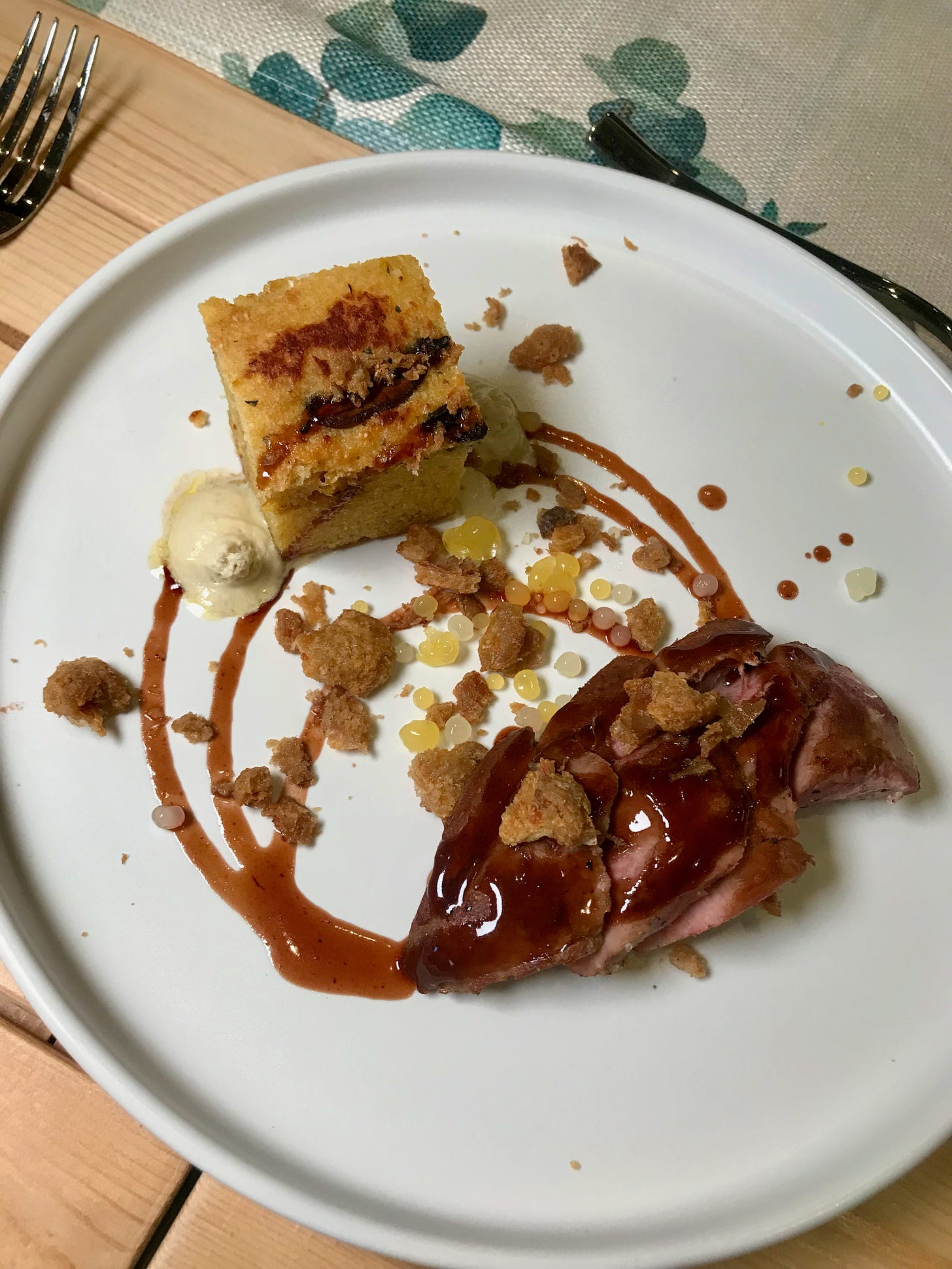
David Cook, Chef/Co-Owner at Gather Food Studio:
There is a special kind of je ne sai quoi that takes an empty plate and transforms it into a remarkable work of art. Before a knife ever touches the cutting board or you hear the ignition clicks of a gas stove trying to catch a flame, food is felt. It's an emotion, and conceptually it begins life as an abstract.
It's a skill that's practiced and constantly evolving — inspired by everyday occurrences like the thoughts evoked from seeing an early morning dewy spiderweb outside your kitchen window or by the way you see one leaf on a tree that has turned red amongst a sea of green ones that makes you think "that's kind of like how I want to plate that special I'm making tonight." It's the colors of life, the magic of nature, and the gift of using abstract ingredient realism tied together with cohesion, or unbound with deconstruction that allows for the eyes to eat first and make the determination of flavor before one morsel of anything crosses the plane of your lips and hits your tongue. It's finding ways to use everyday ingredients and reimagining their potential to push boundaries and create new excitements: like enacting auditory cues (the most underutilized sense as it relates to cooking and eating) to keep the diners constantly guessing what's coming next. It's about as close as you can get as a Chef to the feeling an 8-year-old has on Christmas morning when looking at a sea of presents under the tree and not knowing where to start or which box to open next. That's plating. It's not just using colors to make a Bob Ross-esque painting. It's not just creating height and depth using garnishes of different shapes and sizes. And it surely isn't just deciding to use one edge of a plate while keeping the rest untouched and glimmering under the dimly lit lights of the dining room. It is, but it isn't.
These are all contributing factors, but plating isn't something that can be summed up in a few sentences. Plating is the last pure form of individuality that the diner doesn't see happen; they only see delivered. For 20 years of my life the best part of my day was peering out the little tiny port window on the kitchen door and seeing the look on the patron's face when presented with one of my creations. The 3-second look of awe and astonishment before the fork tines and knife serrations rip through essentially half a lifetime's worth of my own experiences, thoughts, struggles, elations, and amazements. It's like the first couple seconds of the feeling when DMT hits (err... so I've heard from a friend), or the full-body release of endorphins, if you rather. But, but... unlike having to pay for that feeling, it’s free and available at least 100 times a shift. So, plating? Plating isn't the protein at the 6 o’ clock position, the vegetable at the 3 o’clock position and the starch at the 9. Plating is the aggregate of a career that most people will never get to experience. Plating is love that only a chef knows how to give. Go hug a chef.



